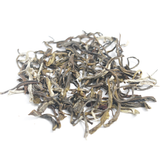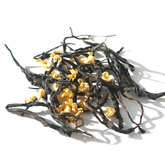Is Jasmine Tea Green Tea? Clarifying the Confusion
In American tea shops or supermarkets, you’ll often find Jasmine Tea displayed in the green tea section. Even at Chinese restaurants, jasmine tea is frequently the most popular tea and gets grouped under green tea on menus. No wonder many tea drinkers wonder: is jasmine tea really a green tea? This mix-up comes from its clear, light-green infusion and the captivating jasmine aroma paired with the familiar green tea flavor. This article will guide you through the American tea-buying environment, clarifying the true relationship between jasmine tea and green tea so you can select the perfect brew for your taste.
What is Chinese Jasmine Green Tea?
Jasmine tea is a type of flower tea made by repeatedly “scenting” fresh tea leaves with jasmine blossoms so they absorb the floral aroma. The base tea—known as the “tea cake”—can be green tea, white tea, oolong tea, or black tea, though green tea is by far the most common foundation. The “scenting” process involves layering dried tea leaves with jasmine petals, allowing the leaves to take on the flower’s fragrance, then removing the petals and repeating this cycle multiple times to create a richly scented tea infusion.

So after this reprocessing, jasmine tea is no longer a traditional green tea. While it retains some green-tea flavor, its dominant characteristic is the jasmine aroma. Under Chinese product standards—much like the EU’s—it must be labeled as “Flavored tea” rather than categorized simply as green tea, even though its primary raw material is green tea.
Why is green tea used as the base for jasmine tea?
Green tea is chosen as the primary tea base for jasmine tea because of its unique processing and chemical composition. Since green tea is unfermented, its leaf cells remain intact and rich in unoxidized catechins and amino acids, which have a strong affinity for aroma molecules. When green tea leaves are layered with fresh jasmine blossoms, these natural compounds effectively capture the jasmine fragrance without being degraded by fermentation or high heat. This results in a richly scented tea infusion whose floral aroma also holds up better during storage compared to other tea types.
Moreover, green tea’s fresh, slightly bitter-sweet flavor pairs beautifully with jasmine’s delicate floral notes. In contrast, black tea or oolong tea, with their higher fermentation levels and bolder taste profiles, tend to overpower jasmine’s subtle aroma—making them less suitable as a base for flower-scented teas like jasmine.
How to Tell If Your Jasmine Tea Has a Green Tea Base
To determine if the jasmine tea in your hands uses green tea leaves as its base, the simplest method is to check the tea packaging for labels like “Jasmine Green Tea” or “茉莉绿茶.” Find the product’s ingredient list or product details, where reputable brands will clearly mark the Base Tea type. By reviewing the listed ingredients, you can confirm whether the flower-scented tea relies on green tea as its foundation.

You can also judge by the tea infusion color after brewing. A green tea–based jasmine tea will steep to a pale green or yellow-green hue, whereas a black tea base produces an amber-red or dark brown brew. On the palate, a green tea–based jasmine tea delivers a fresh, grassy aroma with a light astringency, while oolong or black tea–based versions offer a richer, fuller-bodied experience with distinct fruity or roasted notes.
What Type of Green Tea Is Used in Jasmine Tea?
Most jasmine tea is made with a green tea base, since unfermented green tea leaves can efficiently absorb and retain the fresh floral aroma of jasmine blossoms. But in China, there are many types of green tea, so the choice of green tea leaves for making jasmine tea is also quite diverse.
However, in most cases, famous or premium green teas are not used as the base for jasmine tea, because they would significantly increase the final cost. Instead, more affordable and widely available local green teas are preferred.
Each region in China produces green tea with different flavor profiles, and these regional teas give jasmine tea subtle differences in taste and aroma. Below are some common types of green tea used as a base for jasmine tea.
| Type | Region | Flavor Profile |
|---|---|---|
| Baked Green Tea | Fujian Fuzhou, Guangxi Hengxian | Fresh and clear with sharp jasmine notes |
| Pan-Fried Green Tea | Zhejiang Jinhua, Jiangsu Suzhou | Rich chestnut base with full floral aroma |
| Sun-Dried Green Tea | Yunnan Lincang, Sichuan Ya'an | Wild earthy undertones, strong endurance in multiple infusions |
Things to Watch Out for When Buying Jasmine Tea
The true essence of jasmine tea lies in the careful combination of a green tea base and real jasmine flower scenting—with no added flavors, colorants, or chemicals. However, in the U.S. market, it's not uncommon to find fake or low-quality jasmine teas. So, when shopping, it’s important to be extra cautious.
Avoid buying products labeled as flavored tea—these are often scented with artificial jasmine flavor or blended with dried flowers and sprayed with flavoring agents. Check the ingredient list carefully. If you see “natural flavors” or “artificial jasmine flavor,” the tea likely doesn’t use authentic scenting methods.

Real Chinese jasmine tea gives off a natural, multi-layered floral aroma that lingers for several minutes. If the smell disappears quickly or seems artificial, it's likely low-grade or chemically scented. High-quality jasmine tea can be steeped multiple times and still release that signature jasmine fragrance. In contrast, flavored teas usually lose their scent after just 1 or 2 infusions.
We also recommend avoiding jasmine tea in tea bags. Most tea bags use low-quality broken leaves, resulting in a bitter and flat taste. In comparison, premium loose leaf jasmine tea from China uses whole green tea leaves that produce a fresh, clean flavor without harsh bitterness.
How to Store Jasmine Tea Properly
To properly store jasmine tea, keep in mind three key factors: airtight, dark, and dry. Always store your tea in a sealed, opaque bag to protect it from air and light. This helps preserve the aroma and prevents oxidation of the green tea leaves.Keep the tea in a cool, dry place away from odors, heat, or moisture. Never place jasmine tea near stovetops, sunny windows, or damp areas, as light, heat, humidity, and strong smells can quickly ruin both the aroma and flavor.

After each use, try to squeeze out excess air from the package to minimize oxygen exposure. Jasmine-scented green tea is especially sensitive—frequent opening can lead to faster loss of fragrance, so try to open the package as little as possible.
Shop NPTEA's Premium Chinese Jasmine Tea
Xuezhu – Made with green tea from Guizhou, China. Strong fragrance with a soft, refreshing flavor.
SEE MORE CHINESE TEAS
If you have questions about selecting tea:
Learn-more-about-chinese-tea
If you have questions about the benefits of tea:
Health-benefits-of-chinese-tea
If you have questions about brewing tea:
How-to-brew-loose-leaf-tea






